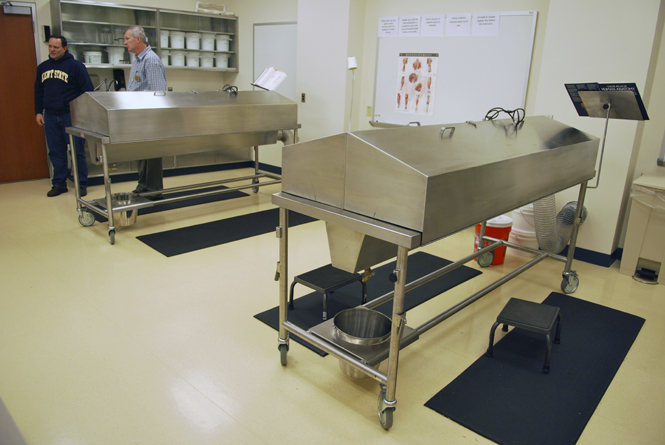Cadaver lab offers unique learning opportunity
Mike Blake, technology program director, and Gary Misich, academic laboratory manager, stand next to cadavers at the Kent State Ashtabula campus. The cadaver lab is the only one within all of the Kent State campuses. Photo by Philip Botta.
February 8, 2011
Kent State Ashtabula’s cadaver lab offers biomedical students hands-on learning through interaction with real bodies.
The lab offers nursing and other health care students the opportunity to learn through physical touch and by watching the professors perform dissections on the cadavers, said Gary Misich, academic lab manager. Students do not do the dissections themselves.
Mike Blake, physical therapist assistant technology program director, said he proposed the idea for a cadaver lab within the Robert S. Morrison Health and Science Building to Dean Susan J. Stocker.
Stocker was initially skeptical because of security and odor concerns, but she did become supportive, Blake said.
Blake said they included locks on each table and an advanced ventilation system to eliminate concern.
Blake researched and went to see other campuses’ similar cadaver labs. He said he wants Ashtabula’s lab to further the students’ learning experience.
The cadaver lab is available to students taking Human Anatomy and Physiology I and II at the Ashtabula branch. These are usually first and second year students, Blake said.
Professors prepare students with lectures and models of the body prior to the cadaver dissections, Misich said.
“The students come into the lab with an understanding of what they’re going to look at. Then they can come into the lab and follow up and see an actual cadaver,” Misich said.
Before students enter the lab, they are required to sign a respect agreement. Blake said they are not allowed to take pictures while inside. So far, they have not had any trouble with violators of the agreement, Blake said.
The lab was built with the option to add in a video system so more students can watch the dissections in a classroom. Misich said they are in the process of making this available.
The lab houses two cadavers at a time. It currently has a male and a female body, Misich said. Bodies that come into the lab can last up to two years, but the lab has gone through more bodies than they expected to.
Each of the cadavers is unique so the students can study different types of bodies, Blake said.
“We learn something new and different from each cadaver that we receive,” Misich said.
The cadavers are sent to the lab through a donation system at Wright State University Medical Center where they are medically embalmed. They are kept until they can no longer be used and are then sent back to the donation center for cremation. Finally, the remains are returned to the families, Blake said.
Blake said he really encourages students to take advantage of the opportunity to touch and feel the body structure because it helps the learning process.
“It sticks in your head much better than reading from a book or looking at the models,” Blake said.
Misich said students are both excited and nervous to work with the cadavers. Blake said he thinks the experience will make them better at their professions.
“I think it will translate to better clinicians,” Blake said. “Our students are going to be able to treat injuries and where they are because they’ve actually seen them in the body and felt them. I think it will help them apply their clinical knowledge even better.”
Contact Brittney Trojanowski at [email protected].












